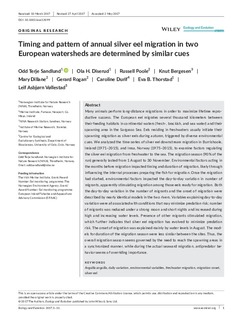| dc.description.abstract | Many animals perform long-distance migrations in order to maximize lifetime reproductive success. The European eel migrates several thousand kilometers between their feeding habitats in continental waters (fresh-,brackish, and sea water) and their spawning area in the Sargasso Sea. Eels residing in freshwaters usually initiate their spawning migration as silver eels during autumn, triggered by diverse environmental cues. We analyzed the time series of silver eel downstream migration in Burrishoole, Ireland (1971–2015), and Imsa, Norway (1975–2015), to examine factors regulating the silver eel migration from freshwater to the sea. The migration season (90% of the run) generally lasted from 1 August to 30 November. Environmental factors acting in the months before migration impacted timing and duration of migration, likely through influencing the internal processes preparing the fish for migration. Once the migration had started, environmental factors impacted the day-to-day variation in number of migrants, apparently stimulating migration among those eels ready for migration. Both the day-to-day variation in the number of migrants and the onset of migration were described by nearly identical models in the two rivers. Variables explaining day-to-day variation were all associated with conditions that may minimize predation risk; number of migrants was reduced under a strong moon and short nights and increased during high and increasing water levels. Presence of other migrants stimulated migration, which further indicates that silver eel migration has evolved to minimize predation risk. The onset of migration was explained mainly by water levels in August. The models for duration of the migration season were less similar between the sites. Thus, the overall migration season seems governed by the need to reach the spawning areas in a synchronized manner, while during the actual seaward migration, antipredator behavior seems of overriding importance. Anguilla anguilla, daily variation, environmental variables, freshwater migration, migration onset, silver eel | |
